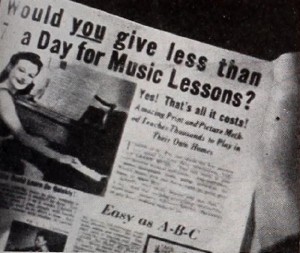
"Lend Me Your Ear is an almost perfect synthesis of shrewd planning, impeccable camera work, smoothly integrated music and general, overall charm. It is gay, glamorous and in good taste. In it, Erma Niedermeyer has caught the lighthearted spirit of 'teen aged American youth. That she was amply aided by her own attractive son was her further good fortune. As the film opens, the Boy is discovered musing over that classic advertisement which guarantees to teach you piano in ten easy lessons. "You too can be the life of the party!" it clarions. The Boy answers the call, the lessons start arriving and the fun begins. There is the light "running gag" of the harried postman, continually overwhelmed by the Boy's enthusiasm as he delivers each new installment; there is the time the piano refuses to play, clogged up as it is by a basketball in its "innards"; there is the tousle headed imitation of Franz Liszt at the age of fourteen — and more. There is, in climax, the Boy's devastating triumph amid a bevy of admiring beauties, as he becomes in truth "the life of the party." Geared to these sequences — which are presented in swift pace and with unerring command of the camera — is a musical accompaniment as suave as the film itself. A single commercial recording provides a slight and recurring background theme. All the remaining score — from the first hesitant scales to the final rocking rendition of a jazz hit — is in the Boy's own playing, especially recorded by Mrs. Niedermeyer to fit her own picture. It is an ineffable and irresistible combination, this Lend Me Your Ear, warmly deserving of the high honor it has won." Movie Makers, Dec. 1943, 457.
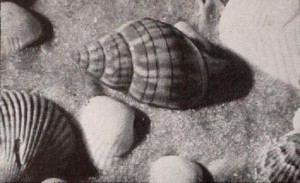
"You may have wandered idly along the seashore and picked up an attractive seashell, but, unless you are a conchologist, you will never know how far an interest in shells will carry you, until you have seen Jewels of the Sea, by W. W. Vincent, jr. This film is a story of collecting seashells. It tells, with freshness and enthusiasm, how shells are discovered on the shore, how they are cleaned and prepared for preservation and how they are studied. On the west coast of Florida, we see hunters searching for specimens ; we visit a shell shop and the home of a collector. The camera, plus color film, reveals the beauty of the specimens and presents intriguing mysteries, for some of the shells were built by mollusks that have never been seen alive. The source of their irridescent beauty is entirely unknown. Jewels of the Sea does not pretend to be an educational film about zoology, but it is informative as well as entertaining, and it is distinguished by flawless camera work." Movie Makers, Dec. 1943, 457, 474.
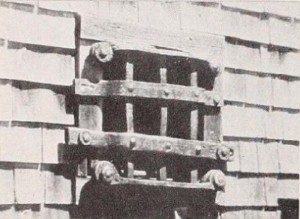
"In filming Nantucket, A Chapter from Early America, Russell T. Pansie chose a happy subject for Kodachrome — the weatherbeaten grays and pastel colors of the ancient buildings of Nantucket. Most color films are made with an effort to present colors as brilliantly as possible, but this picture is a delightful exception, and it is a notable example of the versatility of color film in the hands of a competent cameraman. In Nantucket, A Chapter from Early America, we see the orderly streets of the island, the historic buildings that date from the early Eighteenth Century, the mansions built by the prosperous sea captains of the Nineteenth Century and we glimpse the island's natural charm. But, in the brief footage that he wisely allowed himself, the cameraman has achieved more than an architectural study; he has reproduced the atmosphere of life as it was lived in the past." Movie Makers, Dec. 1943, 474.
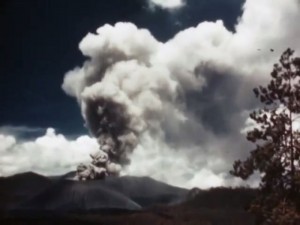
"Paracutin, by Ralph E. Gray, is probably the most complete and accurate record of Mexico's new world wonder yet to be produced on 16mm. film, even possibly in the 35mm. medium. Mr. Gray, long one of Mexico's most devoted American friends, was on the scene soon after the eruption broke out in a peasant's cornfield, and he has made four further trips to record changes and progress in the volcano's life. His superbly filmed footage presents the dramatic subject from every available viewpoint — even to seemingly dangerous closeups of the fiery rim — but it has been edited and is presented in strictly accurate chronological order. Human interest scenes of the effect of the giant cauldron on native life are plentiful and appealing, even to a striking sequence of the heavy dust deposits along the streets of Uruapan, more than thirty miles from the eruption. Paracutin is today a dramatic study of beauty and power; it should prove in the future to be a unique and valuable scientific record." Movie Makers, Dec. 1943, 474.
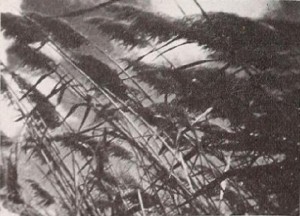
"Herman Bartei has, in Pathetique, made another contribution in the special field which he shares with Walt Disney and Leopold Stokowski — that of setting music to film. In this process, the music is the absolute, to which the footage must conform. While Disney achieves his conformity with drawings, Bartei uses actual cinematography of natural scenes. Mr. Bartel's absolute in this instance is the first movement of Tschaikowsky's Sixth — or Pathetique — Symphony, which is played from start to finish on double turntables, while the film sets forth what its maker feels is an interpretation in motion pictures of the music. The footage consists of autumn scenes, whose subject matter and tempo are varied to agree with the musical expression. The success or failure of this type of effort must depend upon the universality of the conviction of unity between musical and scenic episodes. Mr. Bartei reaches several high spots, notably one in which swirling crows against an angry sky are in very real harmony with the musical statement. Other scenes of autumn mist are very apposite to Tschaikowsky's phrases. The synthesis as a whole is both convincing and emotionally exciting." Movie Makers, Dec. 1943, 474.
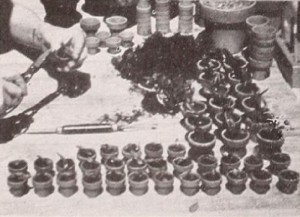
"A. M. Zinner has performed not only a labor of love in Romance of the Hybrid Orchid, but he has made an important contribution to the available information about orchid growing. Given the run of Shaw's Garden, the famous botanical park of St. Louis, he has traced the life of hybrid orchids from seed to full flowering, with especial study of the behind the scenes events in the hot beds and potting rooms. Outstanding is the section of the film devoted to the care and exact technique that must be used in handling seeds while they germinate. With this work of several years, Mr. Zinner takes his place in the ranks of significant amateur naturalists who have provided exhaustive records of some special field. In offering his carefully planned and detailed footage, Mr. Zinner also gives some very lovely flower pictures, including the rarest of the world's orchids. Beautiful camera work and expert sequencing mark the picture." Movie Makers, Dec. 1943, 474.
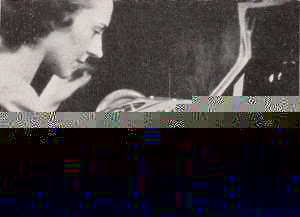
"Morton Read's industrial picture, The Art of Universal Winding, serves a special purpose very convincingly. His client had difficulty in attracting girls to his factory, because the work of wire winding had, in the past, not gained social acceptance in many New England communities. Mr. Read's task was to show that wire winding is an important wartime occupation, that it is interesting, safe and pleasant and that women of superior types are to be found in it. The chief performer in the film is a fine looking woman of dignity and evident character who illustrates the work which must be learned by new employees. The movie is not only educational, as a true training film should be, but it adds its special message naturally and effectively." Movie Makers, Dec. 1943, 474.
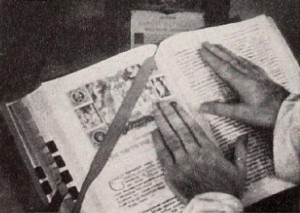
"The Reverend Edward J. Hayes, assisted by his brother, Paul J. Hayes, has made an impressive film record in The Holy Sacrifice of the Mass. All the details of the rite are shown simply and directly. The film was made at close range, and it affords the audience the celebrant's view of the altar. The excellence of the color in this Kodachrome work stresses the beauty of the vestments and of the religious articles. The understanding and devotion behind this effort are evident in the spiritual quality achieved." Movie Makers, Dec. 1943, 477.
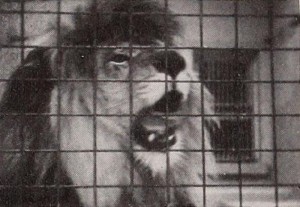
"A Day at the Zoo is a lively and pleasing film of a family's visit to the New York Zoological Gardens. The youngsters of the family discover the Children's Zoo and make the acquaintance of farmyard animals. They feed the chickens and pet the lambs while Father and Mother look on. The larger and stranger beasts in the main part of the Zoological Gardens are next pictured; the children feed them, too, but at a safer distance. In this film, Walter Bergmann has produced the best type of informal zoo picture — a story with human interest, enlivened with a sense of humor." Movie Makers, Dec. 1943, 477.
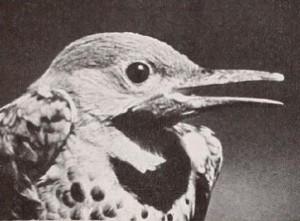
"Henry E. Hird offers the framework of a timely continuity plan for a scientific record in A Letter. A naturalist father writes a film letter to his sailor son who shares the father's scientific interest in bird and insect life, as well as in floral beauty. We see the father writing and the son reading a letter, the information in which is brought to life in film. Mr. Hird is a very capable observer and movie maker, and the combination of these abilities has enabled him to offer, in this informal style, a wealth of information. Extraordinary sequences of nesting birds are included." Movie Makers, Dec. 1943, 477.
Total Pages: 299